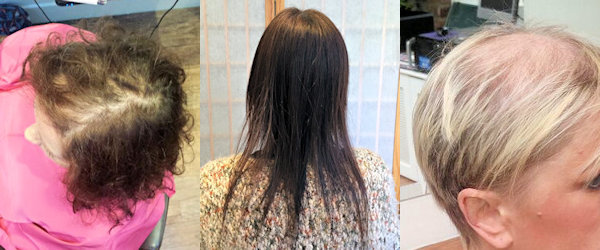Hair loss can be triggered at any age and there are a vast amount of conditions out there, meaning sometimes it’s hard to understand what’s going on or what is wrong. There are some simple steps you can follow to understand whether you are losing your hair and why.

Shedding – normal or not?
The average person sheds between 100 – 150 strands of hair a day, a lot more than people think, so simply seeing hair in the plughole doesn’t necessarily mean there’s something wrong. However if you feel like you’re losing more than this or your hair is getting thinner, and are seeing larger amounts in the shower or when brushing/styling your hair then this can be an early sign that something isn’t right.
Women’s hair can often go through temporary periods of change, caused by hormonal swings, stress, or illness, and will often return to normal in a few weeks; so there’s no need to worry straight away, but you should keep a close eye on it and if it persists then you should investigate further.
Pay attention to your parting…
Your parting can often be one of the first areas of your hair to change, if your parting is widening and you’re finding it hard to cover up, then this is likely to be an early sign that shouldn’t be ignored.
…and your parents
Hair loss can be genetic, so it is also worth tracing back through your family history to see if this could be one of the causes. Did an aunt or a grandmother have very thin hair earlier than might be expected? Or did someone on the family wear wigs?
If there’s no record of hair loss in the family but you’re losing thickness or finding areas where your hair is disappearing then it’s best to seek medical advice to find out if there is a clinical cause, such as thyroid or hormonal problems, before taking any further action.
Thinning, receding, or patchy loss?
Take careful note of the type of loss you are noticing, so you can clearly describe it to your GP or any other professional you speak to. Maybe even take photographs so you and they can assess how matters are progressing. You may know how your hair looked or where the hair line was a few months ago but they are only seeing it as it is now.
- Is your hair getting thinner overall but is otherwise normal?
- Is your hair line receding? And is it at the front or the sides?
- Are there patches where the hair is falling out and/or not regrowing or growing back much thinner than usual?
- Is there any inflammation of the scalp?

Where to turn next?
If there is a clear medical reason for your hair loss then there may well be a treatment available which will return your hair to normal along with your health. However there is much that is not understood about the causes of hair loss and what can trigger it, so if your GP can’t offer any help then you may have to request a referral to a Trichologist for further enquiry. Sometimes unfortunately a diagnosis doesn’t offer prospects of a cure – for instance Frontal Fibrosing Alopecia (characterised by severe receding of the front hairline) is currently considered irreversible – and you have to turn your attention to ways of disguising your hair loss in order to look your best.

This is where we come in. As well as advising you on your level and type of hair loss or who to speak to medically, we have vast experience of using a variety of different techniques to make your hair look normal and healthy– from simple styling ideas for mild loss, through scalp make-up, ultra-fine hair extensions to add body, right through to full 24/7 hair systems to augment or even completely replace your hair. We’ll give you as many options as we can to suit your needs and lifestyle.
In the next post we’ll discuss the different types of hair loss, how they progress and how best to handle them. In the meantime if you’d like to speak to us or come in for a free consultation we’d be happy to hear from you. Call our London number – 0208 741 8224 – or one of our other studios across the UK or drop us an enquiry through one of our contact forms on our main UK site. If you’re in the US then please visit our US website – studios in Los Angeles and New York.
